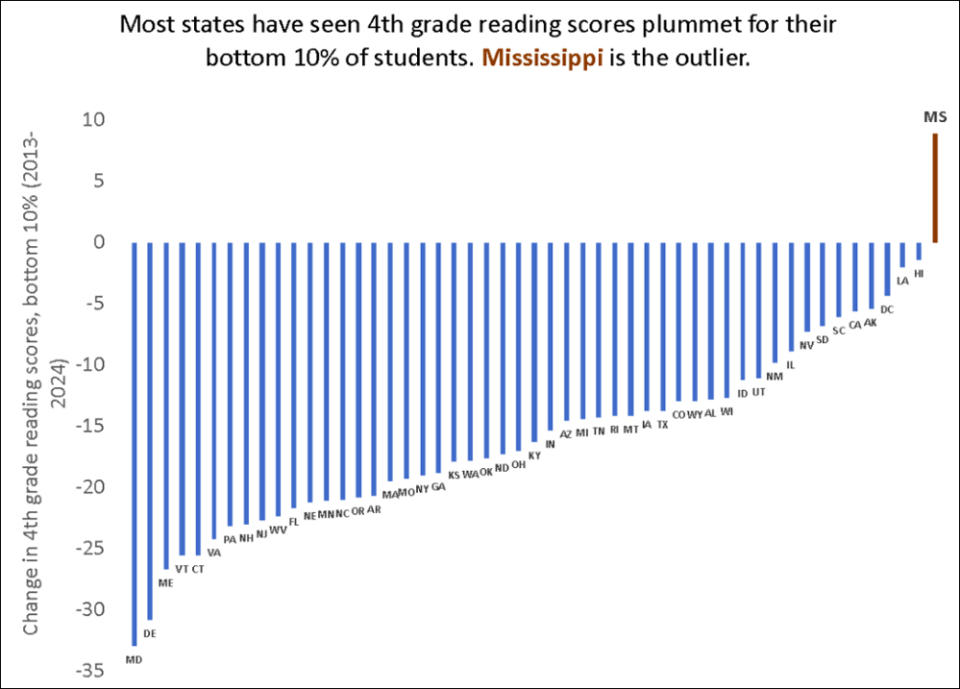Achievement gaps in eighth grade math are growing in every state across the country. But in reading, they’re actually a bit worse. In fact, 10 states — Arkansas, North Carolina, New Hampshire, Massachusetts, West Virginia, Florida, Delaware, Connecticut, New Jersey and Maryland — have seen the gap between their best and their worst readers widen by more than 20 points since 2013.
There are two ways for a gap to grow. The top can pull away, or the bottom can fall out. Here in the United States, the key problem is that the bottom is falling, and the changes are not small. At the national level, in fourth grade reading, the scores of the top 10% of students fell 0.5 points from 2013-24. Meanwhile, the scores of the bottom 10% fell 15 points.
Get stories like this delivered straight to your inbox. Sign up for The 74 Newsletter
The state-level results are even more jarring. To put those in perspective, consider that the average student gains about 8 points per year on the National Assessment of Educational Progress reading tests. The chart below shows the change from 2013 to 2024 in the scores for the bottom 10% of students in each state. For this group, 40 states saw a decline of 10 points or more, 16 saw declines of 20 points or more and two states — Delaware and Maryland — had declines of more than 30 (!) points.
Source: National Center for Education Statistics, National Assessment of Educational Progress (NAEP)
But one state is bucking this trend: Mississippi. Indeed, there’s been a fair amount of coverage of Mississippi’s reading progress in recent years, but its gains are so impressive that they merit another look.
Advertisement
Advertisement
First, it’s worth remembering that Mississippi is the poorest state in the country. Its per-capita income is below $50,000, and it spends less on its public schools than all but three states. But when the Urban Institute adjusted NAEP scores based on each state’s demographics, Mississippi’s fourth-grade reading scores came out on top.
Trump Cuts Research Lab That Helped Nurture ‘Mississippi Miracle’
Even without those adjustments, though, Mississippi looks pretty great. Its Black students rank third nationally, and its low-income kids outperform those in every other state. Mississippi is also the only state to see gains across all performance levels over the last decade. Its average went up, but so did the scores of its highest and lowest performers. Mississippi raised the bar and the floor at the same time.
So how did they do it? How did Mississippi go from 49th in the country a decade ago to near the top today? And what can other states learn from it?
Advertisement
Advertisement
According to a recent piece by Grace Brazeale, a policy associate with the advocacy group Mississippi First, the state implemented a series of changes starting with the 2013 Literacy-Based Promotion Act. That law funded the state department of education to hire, train and deploy literacy coaches to the 50 lowest-performing schools. It also required schools to administer universal screenings to identify students with reading deficiencies early and to communicate those results to parents, and it required schools to hold back students who were not reaching a certain threshold by third grade.
New NAEP Scores Dash Hope of Post-COVID Learning Recovery
These changes were not all that expensive, but they had big effects. EdWeek’s Elizabeth Huebeck reported in 2023 that the state spent $15 million per year to support its literacy work, and 60% of that went to coaching and intervention staff. A research paper last fall from Noah Spencer from the University of Toronto found that the law helped drive the state’s gains.
Spencer estimated that the third-grade retention policy alone could be responsible for about one-quarter of the gains, and it was surely the most controversial element. Some people have even tried to cast doubt on Mississippi’s NAEP gains by arguing they’re merely a function of testing older kids. But this has been debunked: Mississippi does hold back more kids than other states, but it always has, and the average age of Mississippi’s NAEP test-takers has barely budged over time.
Advertisement
Advertisement
More in U.S.
Research on third-grade retention policies has found that students who are retained tend to have better long-term outcomes than those who are not, but that the process for identifying those children can be biased against Black, Hispanic, and low-income students.
However, I think what matters most is not the students who are retained, but what the policy does to adult behavior. Mississippi required schools to notify parents when their child was off track and to craft individual reading plans for those with reading deficiencies. In other words, the threat of retention may have shifted behavior in important ways. As evidence for that theory, consider that a study out of Florida also found positive effects on younger siblings of students who are retained.
New Study: Holding Kids Back One Key Factor in Mississippi’s Reading Revolution
Other states have literacy policies too, but they are often weaker than what Mississippi implemented. For example, a 2023 paper from Michigan State University researchers John Westall and Amy Cummings found that 41 states and the District of Columbia had early literacy policies, but only 12 could be considered truly comprehensive. Many states had the superficial elements of a literacy plan, but they lacked requirements that all districts adopt high-quality instructional materials, screen all students for dyslexia and take dramatic action for kids who continue to struggle to read. Critically, Westall and Cummings found that only states with truly comprehensive policies saw student learning gains.
Advertisement
Advertisement
This is perhaps the key lesson for state policymakers: The only literacy policies that are likely to lead to significant student learning gains are ones that meaningfully change schools and classrooms. With reading scores continuing to fall in many parts of the country, policymakers should look to replicate the lessons from Mississippi.
Former Mississippi Schools Chief Aims to Repeat Learning ‘Miracle’ in Maryland
EMEA Tribune is not involved in this news article, it is taken from our partners and or from the News Agencies. Copyright and Credit go to the News Agencies, email news@emeatribune.com Follow our WhatsApp verified Channel





